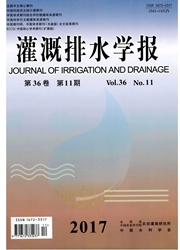

 中文摘要:
中文摘要:
采用实地调查和室内分析等方法,并结合数字图像处理技术,研究了干热河谷冲沟侵蚀劣地坡脚堆积区(PJ)、坡底沉积区(PD)和平地漫流区(PM)土体性质和裂缝形态发育特征,并探讨了土体性质对裂缝形态特征的影响。结果表明,(1)侵蚀劣地坡积区不同部位土体性质差异显著,其中土壤体积质量及黏粒质量分数均表现为PD〉PJ〉PM,毛管孔隙度为PM〉PD〉PJ,有机质为PM〉PJ〉PD;不同部位土体性质极值比:黏粒质量分数最大(1.94),有机质(0.65)次之,再次是毛管孔隙度(0.27),土壤体积质量(0.09)最小;PJ、PD土体性质变化主要受物源特性和沉积方式的影响,而PM土体性质主要与植被分布以及漫流有关。(2)干热河谷侵蚀劣地不同部位土体裂缝形态特征差异也十分显著,其中裂缝长度密度(Lc)及连通性指数(K)均表现为PDPM(Ⅲ号坡积区的Rc除外);表明裂缝发育强度(Rc)及复杂程度(APc、AWMFRAC)PD最高,其次为PJ,再次是PM。(3)相关分析表明,长度密度与土壤体积质量(p=-0.782)、黏粒质量分数(p=-0.626)均呈显著负相关,连通性指数与黏粒质量分数呈显著负相关(p=-0.618),这表明土壤体积质量及黏粒质量分数对裂缝发育产生了重要影响。
 英文摘要:
英文摘要:
Based on investigation, laboratory analysisand digital image processing, we quantitatively analyzed soil properties and morphology of soil cracksin P J, PD and PM. We also discussed the effects of soil properties on development of fracture morphology. The results showed that ①bulk density and clay content was PD 〉PJ 〉 PM; soil porosity was PM 〉 PD 〉 P J; organic matter was PM 〉 PJ 〉 PD. Extreme ratio of soil properties at different lo- cations: the greatest was content of clay (1.94), followed by the organic matter (0.65), soil porosity (0.27)and bulk density (0.09). The difference between soil properties in PJ and PD was due to their different source materi- als and depositions. The PMsoil was mainly affected by vegetation distribution and over-flow-condition.②Lc and K was PD〈PJ〈PM, Rc, APc and AWMFRAC was PD〉PJ〉PM. ③Pearson correlation analysis showed that the length density and bulk density (p=-0.782), clay content (p=-0.626) are negatively correlated. The connectivi- ty index was negatively correlated with clay content (p=-0.618). It was showed that the bulk density and clay con- tent played an important role in crack growth. The results could provide a basis for improving degraded soil and vegetation restoration of the gully badlands in Dry-hot valley region.
 同期刊论文项目
同期刊论文项目
 同项目期刊论文
同项目期刊论文
 期刊信息
期刊信息
